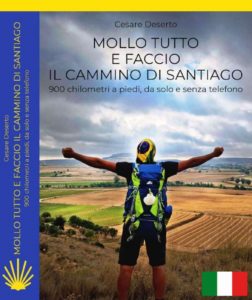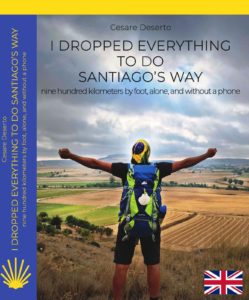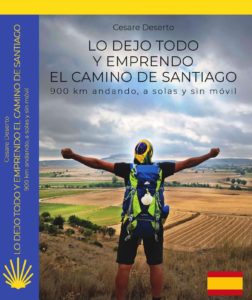The “Credential” is the fundamental document for those who travel the path for religious purposes. This is a booklet that certifies the qualification of a pilgrim distinguishing him from ordinary tourists, guaranteeing the religious character and the seriousness of the pilgrimage and allowing assistance and overnight stays in the approximately numerous “hospitales” or “refugios” found along the Way. The credential has the fundamental function of certifying the stages traveled, allowing access to the hotels for pilgrims, and taking advantage of the pilgrim’s menu in the various restaurants (even if in the latter case I was always and only asked for my credit card. or cash and never to show this document). It can be purchased online at the following link https://www.santiagodecompostela.me/products/official-pilgrim-credencial-pilgrim-passport-from-the-pilgrims-office-in-santiago.
From January 2021 the credential in digital format was also made available, which allows to speed up the pilgrim registration process and the release of the Compostela and the Distance Certificate (now also available in Gallego). This will certainly make many turn up their noses, also because that precious document has always been an excellent and trusted travel companion for the pilgrim as well as being a beautiful memory to frame. Since the traditional credential will also remain in force, pilgrims will still be able to manage the dual mode in order to have both the traditional paper support and benefit from the streamlining of the queue upon arrival in Santiago. Find all the information at the link of the Cathedral of Santiago.
The Confraternity of San Jacopo di Compostella is the only brotherhood authorized directly by the Cathedral of Santiago to issue this document in Italy. You can consult all the information by going to their official website http://www.confraternitadisanjacopo.it/.
I still remember when I went in those days in early July to Rome, in the Trastevere area, to collect mine. At the entrance to the convent, a tree is displayed with the various kilometer distances of the different pilgrimage sites, Jerusalem km 4059, St. Peter km 26, Santiago km 2248 etc. and the memory of three smiling and happy people to welcome me: << Hello Pellegrino >>. Pellegrino…, it was the first time they had called me that, not knowing that I would have heard me called that way thousands of times. Questions about why I did the Way, about its history, about how much my backpack weighed, about the difficulties, but “I had done all my homework” and I knew everything about the Way and was very well prepared, at least in theory. A pleasant chat, some good advice, a prayer and here I am given the credential with my name and surname on it.

The stamps (sellos) of the various places where you pass or stop must be affixed to the Credential; the latter attest to the path taken. The credential is perhaps the most precious object for the pilgrim and I recommend that you keep it in a plastic bag to prevent it from getting wet.

The “Compostela” is instead the certificate drawn up in Latin and issued by the ecclesiastical authority of Santiago de Compostela to those who have made the pilgrimage on foot, by bicycle or on horseback with religious intentions (you can collect it at the Pilgrim’s Workshop located in Rúa Carretas, 33, a few meters from the Praza do Obradoiro).
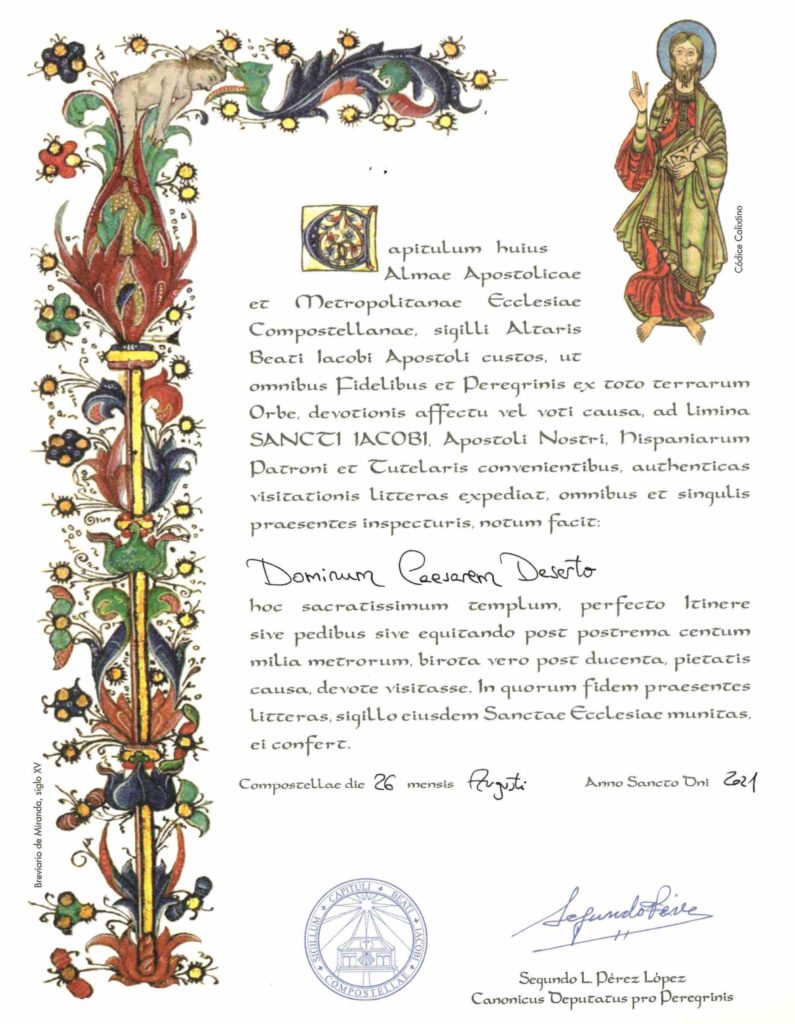
The certificate can only be issued to those who have traveled the Way for strictly religious and spiritual reasons and who present a credential bearing written testimonies (stamps) attesting to having traveled the last hundred kilometers (200 if you are on a bicycle). In the Middle Ages it was a very important document, because pilgrimage was a form linked to the dissolution of vows or the penance of very serious sins. In some cases the pilgrimage was also a civil penalty, that is, the condemned was removed from the community in which he had committed crimes and readmitted only after having made a pilgrimage of conversion. La Compostela certified the expiation of the sentence or vote. In addition to the Compostela you can also collect the Distance Certificate, a document established only recently (in 2014) given the increasing requests of pilgrims to have the distances covered in some way recognized.
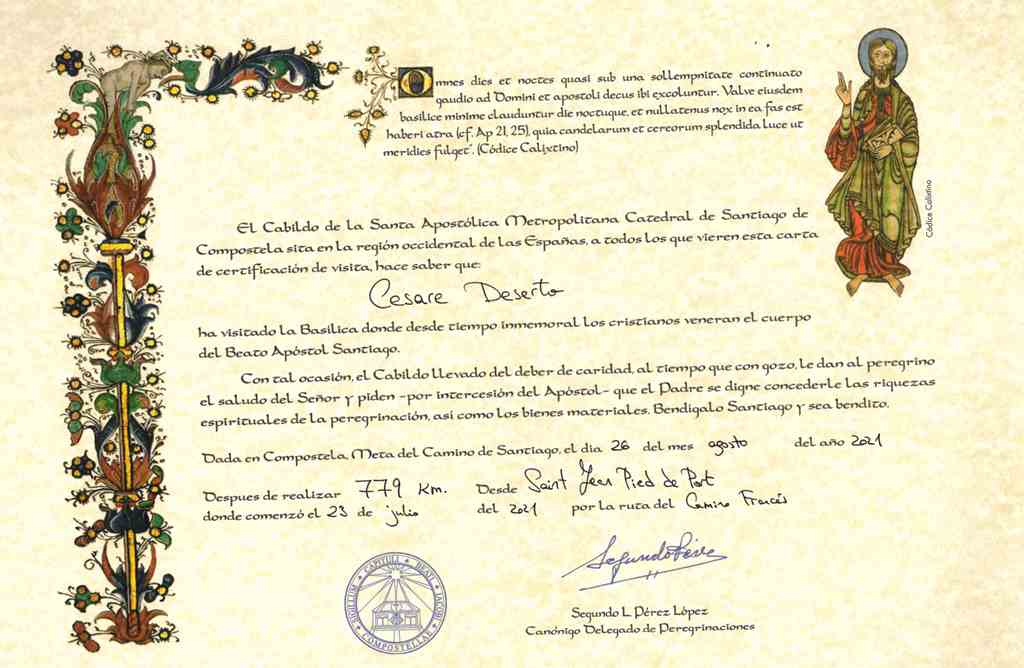
This certificate, unlike the Compostela (issued free of charge), can be obtained upon payment of 3 euros (plus two euros if you also want the tube to better keep it in your backpack), to all pilgrims who are in possession of the necessary stamps to collect the “Compostela”. This document, printed on parchment-like paper and embellished with Latin inscriptions with miniatures of the “Calistino Code”, contains the most important certifications for the pilgrim: day and place where the pilgrim started the Camino de Santiago; the distance (in kilometers) traveled by the pilgrim; the day of arrival of the pilgrim in the city of Santiago de Compostela; the name of the path traveled by the pilgrim. I remind you that the Certificate has no value from a religious point of view and is larger than the Compostela. But I think it is a beautiful memory to be immortalized on paper of the wonderful journey traveled.
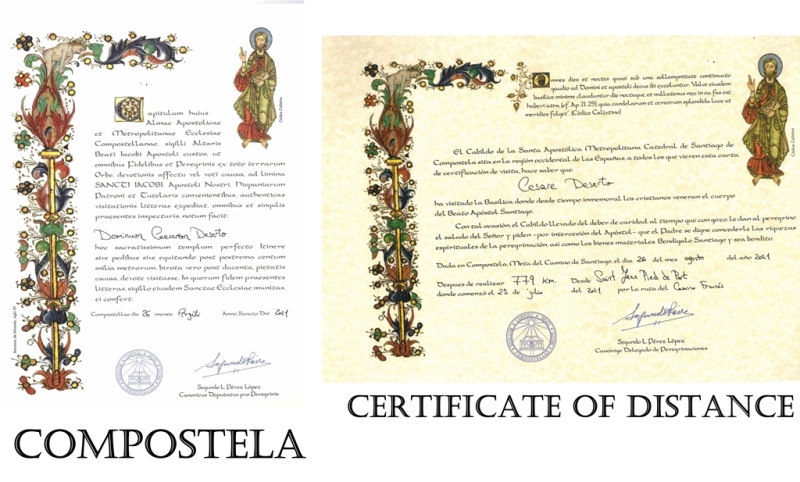
To deepen the subject, to find out more and if you too have decided to walk the Camino de Santiago or dream of wanting to do it sooner or later, I suggest you buy my book where you will find out why every year, 300,000 people from all over the world, they decide to tackle the most famous Way in the world. If you too, like me, have always dreamed of giving up everything, aware that the life you lead is not the one you dreamed of as a boy, perhaps my experience could give you the courage that I lacked for 36 years …
Reading my experience, you will discover in detail and above all proven in the “field”:
- the history of the journey (historical notes, symbols and legends) and symbolic places;
- suitable clothing and shoes, which backpack to buy and above all what to put inside;
- duration and distance of the journey, how many days it takes to complete it and where to start based on the days available;
- how to train before leaving and the necessary physical preparation;
- how much does it cost to walk the path, where to eat and sleep along the path;
- whether walking the path alone can be dangerous for a woman and whether there is a possibility of getting lost;
- the answer to many questions and concerns (which were also mine) posed by many aspiring pilgrims and the possibility of contacting me to dispel all your doubts / hesitations;
- finally, I will tell you why a journalist and radio host gave up his whole life of comfort and materiality, to travel more than 900 km on foot from the Pyrenees to the Atlantic Ocean, alone and without a telephone, sleeping over that in the various hostels also on the street, in a stable, in a tent, in an abandoned monastery and living two days in a hippie community.
…. ” I gave up everything, I left home, sold my car, motorcycle, clothes, my rolex and most of the material things I owned to follow that almost nagging, suffocating, undeterred feeling that once known does not make you find peace: SANTIAGO, the Camino de Santiago. My life needed answers that only a journey in complete solitude could give me “….
If you want to get to know me better, in the link below you will find an interview where I talk about my experience 👇👇👇
https://www.italianmadhouse.com/libri/i-dropped-everything-to-do-santiagos-way-cesare-desertos-book/



